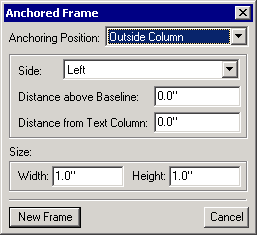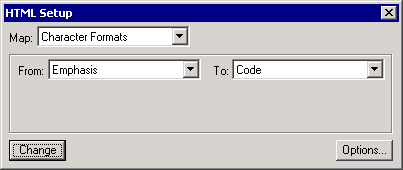FrameMaker 7.0 Tutorial: Reference Pages
About Reference Pages
Reference pages are used to store frequently-used graphics, boilerplate material and clip art, hypertext commands, formatting information for generated lists and indexes, definitions for custom math elements, and mappings for HTML and XML conversions. You can add these elements to existing reference pages, or create your own reference pages to store these elements. FrameMaker provides the following six reference pages:
- Reference (1 of 6) is used to store frequently used graphics .
- HTML (2 of 6)—HTML (5 of 6) is used for HTML and XML conversions.
- Headings (6 of 6) is used to store formatting information for headings.
Displaying Reference Pages
To display reference pages:
- Open a new document, and select File > Save As.
- In the File name box, type referencepages.fm, and click Save.
Note: If you are working in the TCM computer lab, save the file to your lab account. If you do not have a lab account, please contact your instructor. - Select View > Reference Pages.
The Reference reference page appears.
| Tip: You can create additional reference pages (up to 100). To create a reference page, select View > Reference Pages, and the select Special > Add Reference Page. |
Creating Reference Frames
In this exercise, you create a reference frame to use as a part of a paragraph format.
To create a reference frame:
- With the Reference (1 of 6) page displayed, select Graphics > Tools.
- Click (Place a Graphic Frame) to place a graphic frame.
- Draw a graphic frame approximately the same size as the existing Single Line frame.
After you complete the frame, the Frame Name dialog box appears.

- In the Name box, type Dashed Line.
- Click Set.
- Click
 (Set Dashed Line Pattern), and select the dashed line.
(Set Dashed Line Pattern), and select the dashed line.
- Click
 (Draw a Line), and within the graphic frame draw a straight line across the length of the frame.
(Draw a Line), and within the graphic frame draw a straight line across the length of the frame.
Tip: To identify the graphic frame, you can add text above the frame. Click (Draw a Text Line), place your cursor above the frame, and type a name. (For example, type Dashed Line.)
Your reference page entry should look similar to the following.

Applying a Custom Reference Frame
To apply the custom reference frame that you just created:
- Select View > Body Pages.
- Place your cursor in the document, and type Chapter 1.
- Apply the Title paragraph format to this text.
- Open the Paragraph Designer (Ctrl+M), and verify that the Title paragraph tag is selected in the Paragraph Tag pull-down menu.)
- From the Basic tab, select Left from the Alignment pull-down menu, and click Update All.
- Click the Advanced tab, and select Dashed Line from the Frame Below Pgf pull-down menu.
- Click Update All.
The Title paragraph tag is updated to include a dashed line. Your text should look similar to the following.
Creating Boilerplate Graphics
Boilerplate graphics allow you to create a consistent visual format. In this exercise, you create a reference frame to store a boilerplate graphic that is placed outside the text frame. Before you create the boilerplate graphic, you must download the graphic file, add a reference page, and modify the page layout.
To download the graphic file:
- Select the following link: tip.gif
Note: Earlier versions of Netscape may attempt to display this file directly. To force Netscape to download this file, right-click the link above, and select Save Link Target As. - Select the directory in which to save the file, and click Save.
- Click Save.
| Note: If you are working in the TCM computer lab, save the file to your lab account. If you do not have a lab account, please contact your instructor. |
To add a reference page and modify the page layout:
- Select View > Reference Pages.
- Select Special > Add Reference Page.
The Add Reference Page dialog box appears.

- In the Name box, type Icons.
- Select View > Master Pages.
- Select Format > Page Layout > Column Layout.
- In the Column Layout dialog box, select Room for Side Heads, and click Update Entire Flow.
- Press Ctrl, select the text frame, and copy it (Ctrl + C).
- Select View > Reference Pages, and paste (Ctrl + V) the text frame into your Icons reference page.
To create a boilerplate graphic:
- Place your cursor in the text frame that you just pasted. (If the text frame is still selected, double-click inside the text frame.)
- Select Special > Anchored Frame.
The Anchored Frame dialog box appears.

- From the Anchoring Position pull-down menu, select Outside Column.
- Click New Frame.
- With the frame selected, select File > Import > File.
- Locate the directory in which you saved the graphic file, select tip.gif, and click Import.
The Imported Graphic Scaling dialog box appears.

- Select Custom dpi, and type 96.
- Click Set.
To place the boilerplate graphic:
- Select the anchored frame, and press Ctrl + C to copy it.
- Select View > Body Pages.
- Place your cursor within your document, and press Ctrl + V to paste the anchored frame.
The graphic is copied to the left margin.
Changing HTML Mappings
When you convert files to HTML or XML, FrameMaker maps paragraph formats to HTML formats. These mappings are represented on reference pages 2-6. Before you begin, select View > Reference Pages, and look at the default HTML mappings.
To change HTML mappings:
- With the body page still active, select File > Utilities > HTML Setup.
The HTML Setup dialog box appears.

- From the Map pull-down menu, select Character Formats.
- From the From pull-down menu, select Emphasis, and select Code from the To pull-down menu.
- Click Change.
- To verify that the change occured, select View > Reference Pages, and look at the HTML Mapping Table on page 3.
The entry for C:Emphasis should look similar to the following.

The Emphasis character format is now mapped to the Code HTML tag. When you export a document to HTML, any text formatted with the Emphasis paragraph format will appear as code in HTML.
Storing Custom Math Elements
FrameMaker allows you to define custom math elements. These custom math elements are stored on a reference page named FrameMath. You can insert these elements using the Equations palette. In this exercise, you define and store a custom math element on a new reference page. For more information about math elements and equations, refer to Adobe FrameMaker 7.0 Online Help.
To create and store a custom math element:
- From any reference page, select Special > Add Reference Page.
- In the Name box, type FrameMath, and click Add. (You must type FrameMath exactly as it appears in this procedure.)
- Click (Place a Graphic Frame), and draw a small graphic frame.
- In the New Frame box, type MyMultiply, and click Set.
- With the graphic frame selected, select (Draw a Text Line), and type x within the frame.
- Select the graphic frame, and click
 (Display the Equations Palette) to open the Equations palette.
(Display the Equations Palette) to open the Equations palette.
- From the Equations pull-down menu, select Add Definition to Catalog.
- From the Type pull-down menu, select Infix, and click Add.
Your custom math element is now available through the Insert Math Element list located on the Equations palette.
To verify that your custom math element is available:
- Select View > Body Pages.
- Place your cursor within the text frame.
- From the Equations Palette, select New Medium Equation (!ms) from the Equations pull-down menu, and then select Insert Math Element.
The Insert Math Element dialog box appears.

- Select the Show Custom Only check box, and then select MyMultiply from the Element list.
- Click Insert.
Your equation should look similar to the following.

For more information about equations, refer to the FrameMaker Online Help.


Comments